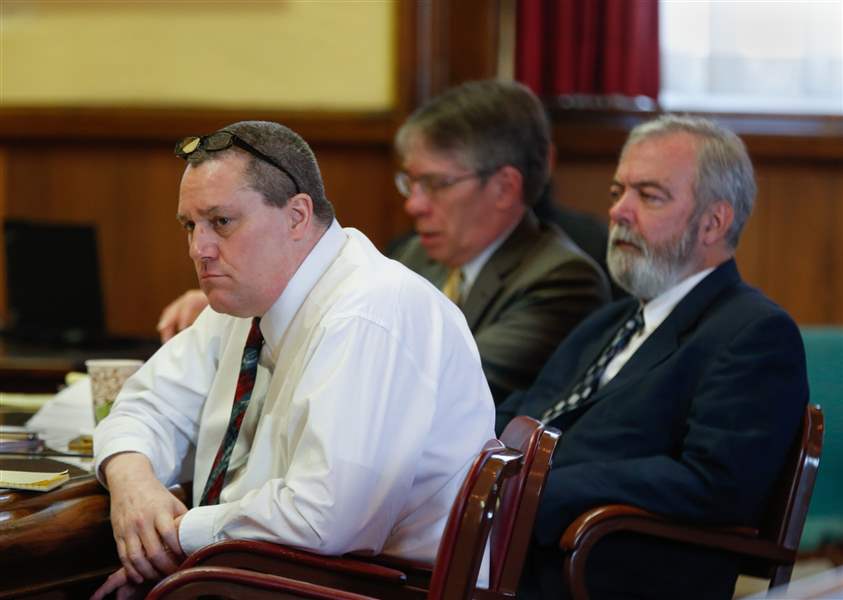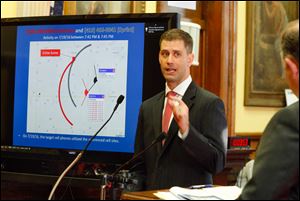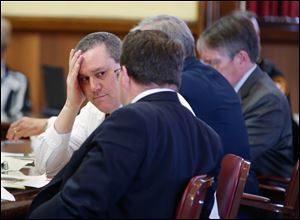
Day 5 of James Worley trial centers on DNA, phone data
3/16/2018
Defendant James Worley, left, with attorneys Mark Powers, center, and Mark Berling, right, while his third attorney, Merle Dech, cross-examines Emily Miller, from Ohio BCI.
The Blade/Jetta Fraser
Buy This Image
WAUSEON — DNA from Sierah Joughin, James D. Worley — or a mixture of both — was found at three key locations connected to her disappearance and murder, forensic scientists testified on Friday.
Testimony in the trial of the man accused of Ms. Joughin’s 2016 murder centered Friday on DNA and cell-phone evidence, two things prosecutors laid out in opening statements as crucial to their case.

FBI agent Joseph Jensen, who was a cellular analyst in July 2016, explains his conclusions as to the relative locations of Sierah Joughin's cell phone and James Worley's cell phone on the evening of July 19, 2016. Testimony continued Friday in the capital murder trial of James D. Worley, 58, in Fulton County Common Pleas Court in Wauseon. Worley is accused of murdering Sierah Joughin, a 20-year-old University of Toledo student, in July, 2016.
Ms. Joughin’s DNA was on her bike and swab takes from the cornfield at the alleged abduction scene on County Road 6, testified Devonie Herdeman, a forensic scientist with the Ohio Bureau of Criminal Investigation. Worley’s DNA was identified on a pair of sunglasses found at that scene.
“No two people have the same DNA except identical twins ... and it’s the same throughout” the body, meaning blood and cheek swabs from someone would yield the same DNA, she said, explaining why it’s a helpful investigative tool.
DAY 1: Initial interviews with Worley played on first day of murder trial | DAY 2: BCI agent testifies during 2nd day of Worley murder trial I DAY 3: Testimony focuses on pornography searches I DAY 4: Financials, injuries focus of proceedings
Ms. Joughin’s blood was on a motorcycle helmet recovered, while Worley’s DNA was found there in a smaller amount. Worley had told investigators in taped interviews he’d lost a helmet, sunglasses, fuses, and a screwdriver in that area when his motorcycle broke down.
Worley’s DNA was present on several items on his County Road 6 property, including a blanket in a barn that tested positive for his semen. Also on the property were an air mattress and stained paper towels with Ms. Joughin’s DNA, said BCI forensic scientist Timothy Augsback.

Defendant James Worley speaking with one of his defense attorneys, Merle Dech.
A rubber glove found on County Road 7 near the grave had both Worley’s and Ms. Joughin’s DNA, Ms. Herdeman said.
A piece of duct tape recovered during the investigation also had both of their DNA.
In several instances, such as on the walls of the freezer in Worley’s barn, samples that, according to previous testimony, had tested “presumptive positive” for blood had no DNA profile, witnesses said Friday. Other items tested indicated some DNA present but it was insufficient for conclusive findings.
Substances such as bleach, rust, or blood from another mammal can trigger a false positive on initial tests until DNA testing can confirm what is actually present, Ms. Herdeman said. Items found on Ms. Joughin’s body, including socks and an adult diaper, also had no DNA profile identified.
Ms. Herdeman said that wouldn’t be surprising given the victim was buried, and “soil and any decomposition” could affect testing.
Defense attorney Merle Dech asked witnesses if they could determine when or where the DNA was deposited on the items. All said they could not.
Jurors on Friday also heard about cell-phone-location technology from Joseph Jensen, an FBI agent who worked on the Cellular Analysis Survey Team in Detroit in 2016.
He explained how law enforcement can match records from cell phones and the towers of their respective providers to obtain locations for certain dates and times of calls, texts, and data usage.
Through activity from two phones — Ms. Joughin's Verizon phone and Worley's Sprint phone, Agent Jensen showed the distance each phone was from the tower to which it connected on the evening of July 19 when she disappeared.
He noted calls made from Worley's phone at 7:43 and 9:13 p.m. The 7:43 call placed his phone near where data placed Ms. Joughin's phone around the same time, the agent testified.
When asked what he made of the information, Agent Jensen replied: “That the phones were in the same general area of each other ... at the same time.”
Worley, 58, of rural Delta, Ohio, is charged with two counts of aggravated murder — both with death-penalty specifications — as well as four counts of kidnapping, two counts each of murder, abduction, felonious assault, and having weapons while under disability, and one count each of possessing criminal tools, gross abuse of a corpse, and tampering with evidence.
Testimony will not take place Monday but will resume Tuesday morning in Fulton County Common Pleas Court.
Contact Lauren Lindstrom at llindstrom@theblade.com, 419-724-6154, or on Twitter @lelindstrom.